tow OLDSMOBILE BRAVADA 1998 Service Manual
[x] Cancel search | Manufacturer: OLDSMOBILE, Model Year: 1998, Model line: BRAVADA, Model: OLDSMOBILE BRAVADA 1998Pages: 380, PDF Size: 19.2 MB
Page 234 of 380
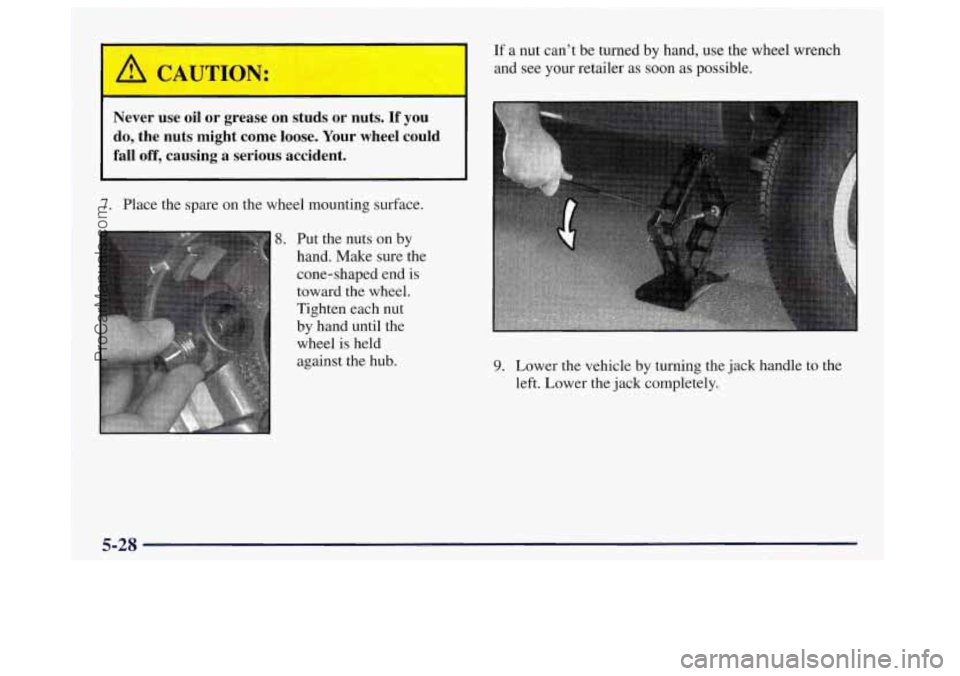
I
If a nut can’t be turned by hand, use the wheel wrench
and see your retailer as soon as possible.
Never use oil or grease on studs or nuts. If you
do, the nuts might come loose. Your wheel could
fall
off, causing a serious accident.
7. Place the spare on the wheel mounting surface.
8. Put the nuts on by
hand. Make sure the
cone-shaped end is
toward the wheel.
Tighten each nut
by hand until the
wheel
is held
against the hub.
9. Lower the vehicle by turning the jack handle to the
left. Lower the jack completely.
5-28
ProCarManuals.com
Page 239 of 380
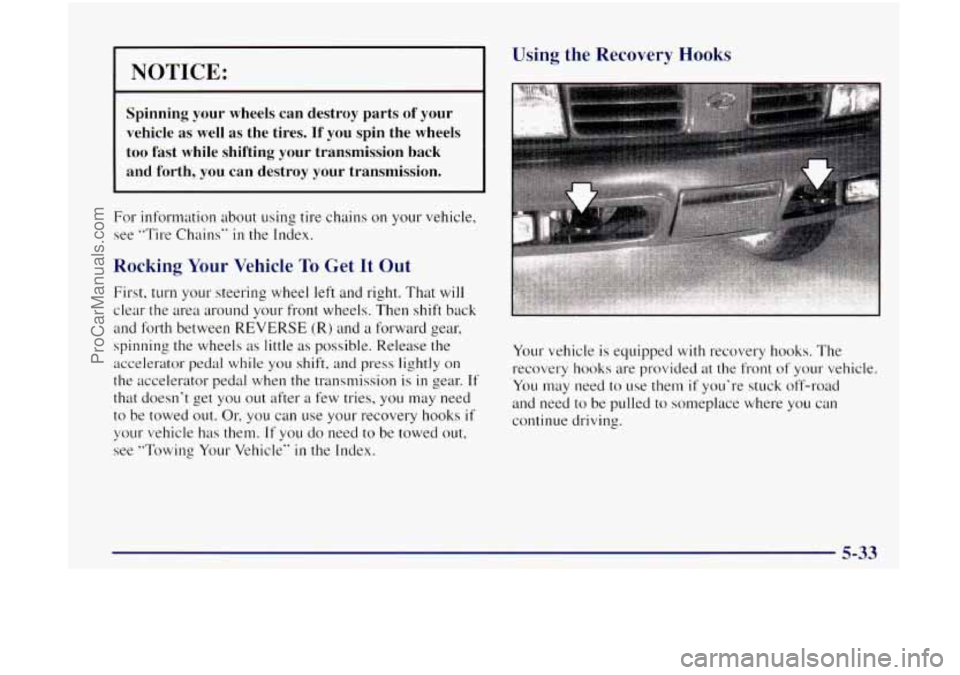
NOTICE:
Spinning your wheels can destroy parts of your vehicle as well as the tires. If you spin the wheels
too fast while shifting your transmission back
and forth, you can destroy your transmission.
For information about using tire chains on your vehicle,
see "Tire Chains"
in the Index.
Rocking Your Vehicle To Get It Out
First, turn your- steering wheel left and right. That will
clear the area around
your front wheels. Then shift back
and forth between
REVERSE (R) and a forward gear,
spinning the wheels as
little as possible. Release the
accelerator pedal while you
shift, and press lightly on
the accelerator pedal when the transmission is in gear. If
that doesn't get you out after a few tries, you may need
to be towed out. Or, you can use your recovery hooks
if
your vehicle has them. If you do need to be towed out,
see "Towing Your Vehicle''
in the Index.
Using the Recovery Hooks
Your vehicle is equipped with recovery hooks. The
recovery
hooks are provided at the front of your vehicle.
You may need to use them
if you're stuck off-road
and need to be pulled to someplace where you can
continue driving.
5-33
-
ProCarManuals.com
Page 240 of 380
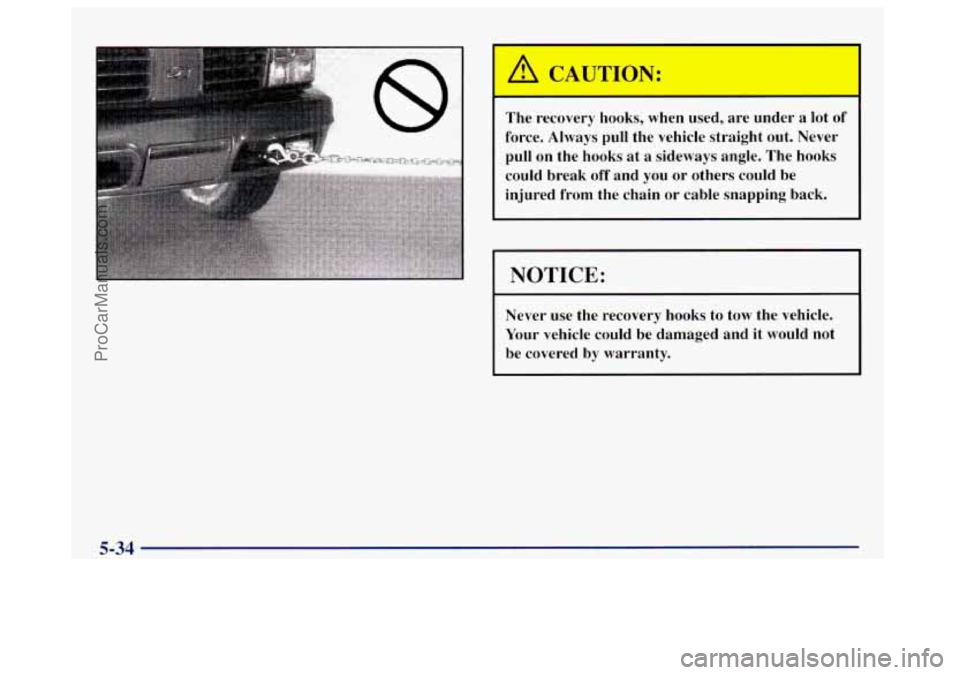
The recovery hooks, when used, are under a lot of
force. Always pull the vehicle straight out. Never
pull on the hooks at a sideways angle. The hooks
could break off and you or others could be
injured from the chain or cable snapping back.
I NOTICE:
Never use the recovery hooks to tow the vehicle.
Your vehicle could be damaged and it would not
be covered by warranty.
ProCarManuals.com
Page 253 of 380
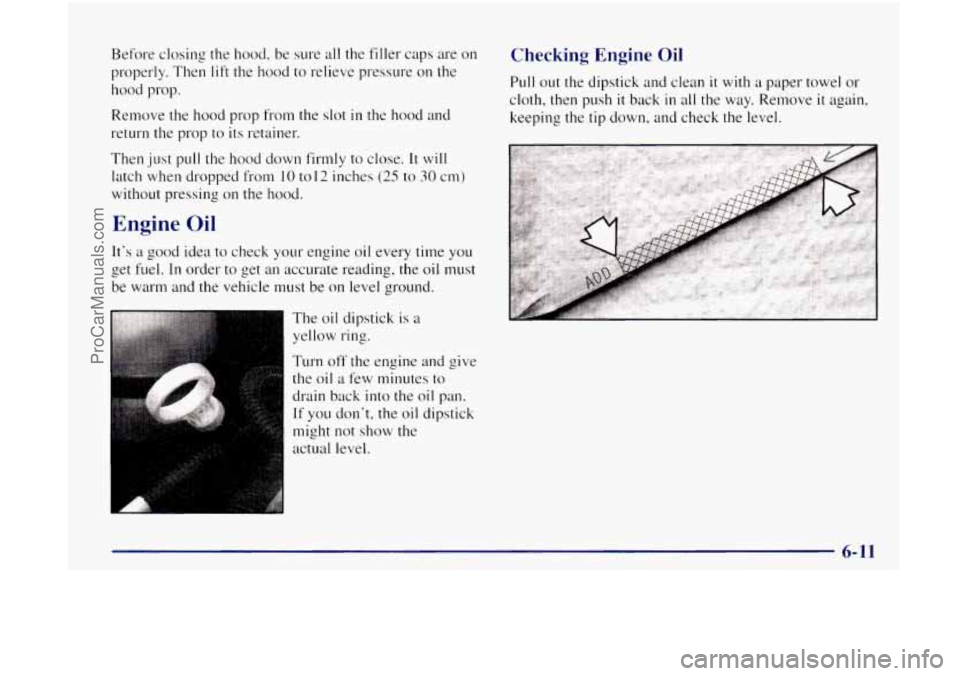
Before closing the hood, be sure all the filler caps are on
properly. Then
lift the hood to relieve pressure on the
hood prop.
Remove the hood
prop from the slot in the hood and
return the prop to its retainer.
Then just pull the hood down firmly to close.
It will
latch when dropped from
10 to 12 inches (25 to 30 cm)
without pressing on the hood.
Engine Oil
It's a good idea to check your engine oil every time you
get fuel.
In order to get an accurate reading, the oil must
be warm and the vehicle must be on level ground.
The
oil dipstick is a
yellow ring.
Turn off the engine and give
the oil
a few minutes to
drain back into the oil pan.
If you don't, the oil dipstick
might not show the
actual level.
Checking Engine Oil
Pull out the dipstick and clean it with a paper towel or
cloth, then push
it back in all the way. Remove it again,
keeping the
tip down, and check the level.
ProCarManuals.com
Page 256 of 380

Engine Oil Additives
Don’t add anything to your oil. Your retailer is ready to
advise if you think something should be added.
When to Change Engine Oil
If any one of these is true for you, use the short triplcity
maintenance schedule:
0
0
0
e
0
Most trips are less than 5 to 10 miles (8 to 16 km).
This is particularly important when outside
temperatures are below freezing.
Most trips include extensive idling (such as frequent
driving
in stop-and-go traffic).
You operate your vehicle in dusty areas or
off-road frequently.
You frequently tow a trailer or use a carrier on top of
your vehicle.
The vehicle is used for delivery service, police. taxi
or other commercial application. Driving under these conditions
causes engine oil to
break down sooner.
If any one of these is true for your
vehicle, then you need to change your
oil and filter
every 3,000 miles (5 000 km) or 3 months -- whichever
occurs first.
If none of them is true, use the long triplhighway
maintenance schedule. Change the oil and filter every
7,500 miles (12 500 km) or 12 months -- whichever
occurs first. Driving a vehicle with
a fully warmed
engine under highway conditions causes engine oil to
break down slower.
Remote Oil Filter
The access door for the remote oil filter is in the steering
linkage shield assembly located under the radiator
support. Twist the screw to unlock or lock the door.
If
you open the door, make sure it is securely closed when
you are finished.
ProCarManuals.com
Page 258 of 380
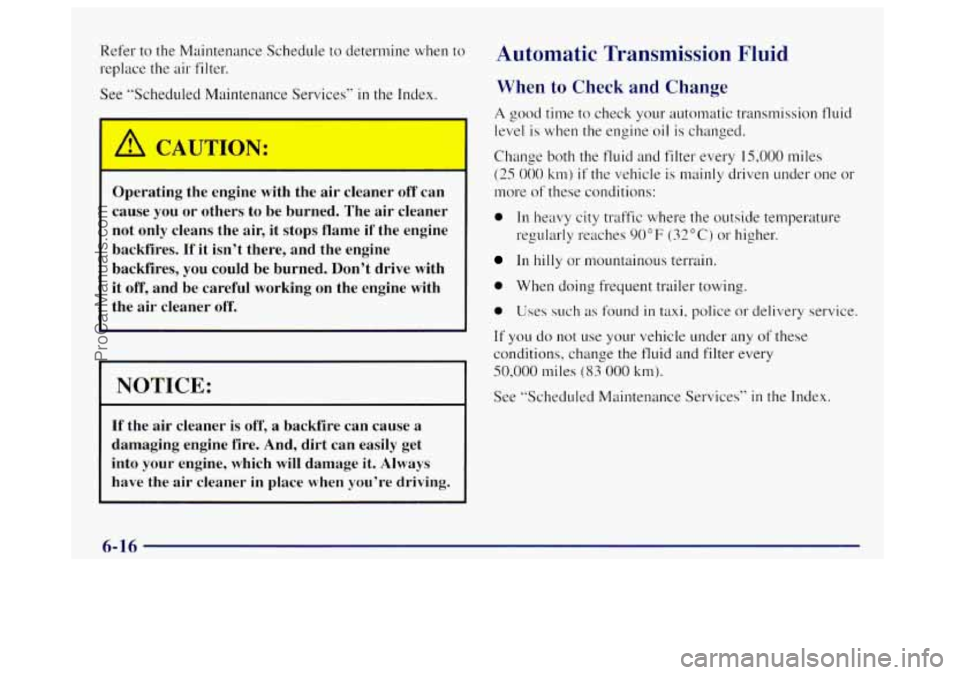
Refer to the Maintenance Schedule to determine when to
replace the air filter.
See “Scheduled Maintenance Services”
in the Index.
Operating the engine with the air cleaner off can
cause you or others to be burned. The air cleaner
not only cleans the air, it stops flame
if the engine
backfires.
If it isn’t there, and the engine
backfires,
you could be burned. Don’t drive with
it off, and be careful working on the engine with
the air cleaner off.
I NOTICE:
If the air cleaner is off, a backfire can cause a
damaging engine fire. And, dirt can easily get
into your engine, which will damage
it. Always
have the air cleaner in place when you’re driving.
Automatic Transmission Fluid
When to Check and Change
A good time to check your automatic transmission fluid
level
is when the engine oil is changed.
Change both the fluid and filter every
15,000 miles
(25
000 km) if the vehicle is mainly driven under one or
more
of these conditions:
0 In heavy city traffic where the outside temperature
regularly reaches
90°F (32°C) or higher.
In hilly or mountainous terrain.
0 When doing frequent trailer towing.
0 Uses such as found in taxi, police or delivery service.
If you do not use your vehicle under any of these
conditions, change the
fluid and filter every
50,000 miles (83 000 km).
See ”Scheduled Maintenance Services” in the Index.
6-16
ProCarManuals.com
Page 260 of 380

Checking Transmission Fluid Cold
A cold check is made after the vehicle has been sitting
for eight hours or more
with the engine off and is used
only as a reference. Let the engine run at idle for five
minutes
if outside temperatures are 50°F (10°C) or
more. If it's colder than
50°F (lO"C), you may have to
idle the engine longer. Should the fluid level be low
during
a cold check, you must perform a hot check
before adding fluid. This will give you a more accurate
reading of the fluid level.
Checking the Fluid Hot or Cold
Park your vehicle on a level place. Keep the
engine running.
With the parking brake applied, place the shift lever
in
PARK (P).
With your foot on the brake pedal, move the shift
lever through each gear range, pausing for about
three seconds
in each range. Then, position the shift
lever in PARK (P).
0 Let the engine run at idle for three minutes or more. Then,
without shutting off the engine, follow
these steps:
I. Flip the handle up
and then pull out
the dipstick and
wipe it
with a clean
rag or paper towel.
2. Push it back in all the way, wait three seconds and
then
pull it back out again.
6-18
ProCarManuals.com
Page 281 of 380

Tire Inspection and Rotation
Tires should be rotated every 6,000 to 8,000 miles
(10 000 to I3 000 km). Any time you notice unusual
wear, rotate your tires as
soon as possible and check
wheel alignment. Also check for damaged tires or
wheels. See “When
It’s Time for New Tires” and
“Wheel Replacement” later
in this section for
more information.
The purpose of regular rotation is to achieve more
lrniform wear for all tires on the vehicle. The first
rotation is the most important. See ”Scheduled
Maintenance Services”
in the Index for scheduled
rotation intervals. When rotating your
tires, always use the correct rotation
pattern shown here.
If your vehicle has a compact spare tire, don’t include it
in your tire rotation.
After the tires have been rotated, adjust the front and
rear inflation pressures as shown
on the
CertificatiodTire label. Make certain that all wheel nuts
are properly tightened. See “Wheel
Nut Torque’‘ in
the Index.
Rust or dirt on a wheel, or on the parts to which
it is fastened, can make wheel nuts become loose
after a time. The wheel could come off and cause
an accident. When you change
a wheel, remove
any rust or dirt from places where the wheel
attaches to the vehicle. In an emergency, you can
use a cloth or a paper towel
to do this; but be
sure to use a scraper or wire brush later, if you
need to, to get all the rust or dirt off. (See
“Changing a Flat Tire” in the Index.)
ProCarManuals.com
Page 288 of 380
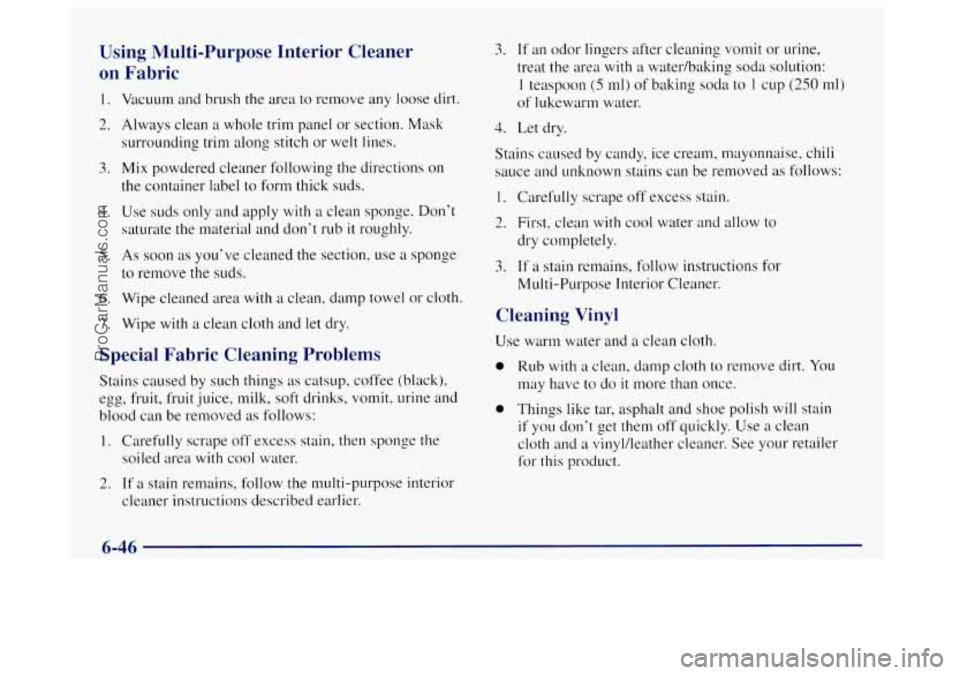
Using Multi-Purpose Interior Cleaner
on Fabric
1.
2.
3.
4.
5.
6.
7.
Vacuum and brush the area to remove any loose dirt.
Always clean a whole trim panel or section. Mask
surrounding
trim along stitch or welt lines.
Mix powdered cleaner following the directions
on
the container label to form thick suds.
Use suds only and apply
with a clean sponge. Don’t
saturate the material and don’t rub it roughly.
As soon as you’ve cleaned the section, use a sponge
to remove the suds.
Wipe cleaned area
with a clean, damp towel or cloth.
Wipe with
a clean cloth and let dry.
Special Fabric Cleaning Problems
Stains caused by such things as catsup, coffee (black),
egg, fruit, fruit juice, milk, soft drinks, vomit, urine and
blood can be removed as follows:
I. Carefully scrape off excess stain, then sponge the
soiled area
with cool water.
2. If a stain remains, follow the multi-purpose interior
cleaner instructions described earlier.
3. If an odor lingers after cleaning vomit or urine,
treat the area
with a watedbaking soda solution:
1 teaspoon (5 ml) of baking soda to 1 cup (,250 ml)
of lukewarm water.
4. Let dry.
Stains caused by candy, ice. cream, mayonnaise, chili
sauce and unknown stains can be removed as follows:
1. Carefully scrape off excess stain.
2. First, clean with cool water and allow to
dry completely.
3. If a stain remains, follow instructions for
Multi-Purpose Interior Cleaner.
Cleaning Vinyl
Use warm water and a clean cloth.
0 Rub with a clean, damp cloth to remove dirt. You
may have
to do it more than once.
0 Things like tar, asphalt and shoe polish will stain
if you don’t get them off quickly. Use a clean
cloth and
a vinylheather cleaner. See your retailer
for this product.
6-46
ProCarManuals.com
Page 290 of 380

Cleaning the Outside of the
Windshield, Backglass and
Wiper Blades
If the windshield is not clear after using the windshield
washer. or
if the wiper blade chatters when running, wax,
sap or
other material may be on the blade or Windshield.
Clean the outside of the windshield
with GM
Windshield Cleaner, Bon Ami@ Powder (non-scratching
glass cleaning powder), GM Part
No. 10500 I 1. The
windshield is clean
if beads do not form when you rinse
it with water.
Grime from the windshield will stick to the wiper blades
and affect their performance. Clean
the blade by wiping
vigorously with a cloth soaked in full-strength windshield
washer solvent. Then rinse the blade with water.
Check the wiper blades and clean them as necessary:
replace blades that
look worn.
Weatherstrips
Silicone grease on weatherstrips will make them last
longer, seal better, and not stick or squeak.
Apply
silicone grease with a clean cloth at least every six
months. During very cold, damp weather more frequent application
may be required. (See “Recommended
Fluids
and Lubricants” in the Index.)
Cleaning the Outside of Your Vehicle
The paint finish on your vehicle provides beauty, depth
of color, gloss retention and durability.
Washing Your Vehicle
The best way to preserve your vehicle’s finish is to keep it
clean by washing it often with lukewarm or cold water.
Don’t wash your vehicle
in the direct rays of the sun.
Don‘t
use strong soaps or chemical detergents. Use
liquid hand. dish
or car washing (mild detergent) soaps.
You can get GM-approved cleaning products from your
retailer. (See “Appearance Care and Materials?’
in the
Index.) Don’t use cleaning agents that are petroleum
based, or that contain acid
or abrasives. All cleaning
agents should be flushed promptly and not allowed to
dry on the surface, or they could stain. Dry the finish
with a soft, clean chamois or an all-cotton towel to
avoid surface scratches and water spotting.
High pressure car washes may cause water to enter
your vehicle.
6-48
ProCarManuals.com